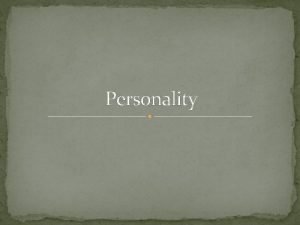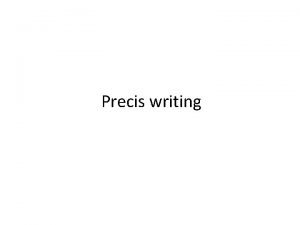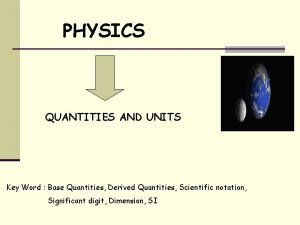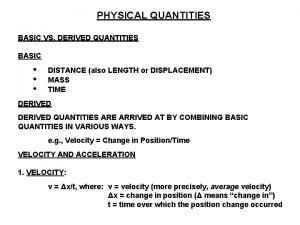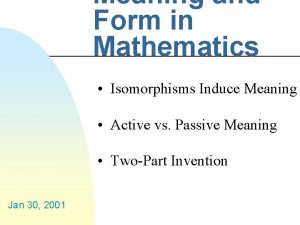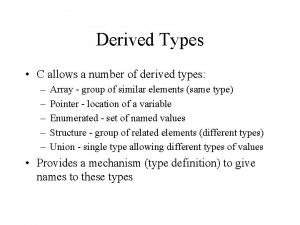Personality Meaning of Personality Personality is derived form















- Slides: 15

Personality

Meaning of Personality �Personality is derived form Latin word persona which means mask. �Greek actors used a mask to hide their identity on stage. �Later it was used by Romans to denote ‘as one appears to others’ not as one actual is.

Definitions �According to Gordon Allport, “Personality is the dynamic organization within the individual of those psychological systems that determine his unique adjustment to his environment. �According to Floyd L. Ruch, “Personality includes external appearance and behavior, inner awareness of self as a permanent organizing force and the particular pattern or organization of measurable traits, both inner and outer. ”

Personality Consciousness �According to Freud, “ Consciousness is that segment of the mind which is concerned with immediate awareness. ” Ego Conscious mind Unconscious mind Superego Id

Personality Consciousness �It is concerned with: �A desire to create favorable first impression. �A desire to judge accurately the personalities of others.

How to form a first impression? �Asch says, “ We look at a person and immediately a certain impression of his personality forms itself in our mind. ” �First impression may be based on physical appearance, facial features or expression, gestures, dress, name, nationality, race, what the person says and how he says it, what he does and how he does it, or some other physical or psychological characteristic which is identified in the mind of the observer with a certain personality type or stereotype.

How to form a first impression? �All characteristics don’t have same impression creating value:

How to form a first impression? �Significance of a particular physical or psychological feature may vary from person to person. �Example: Mc. Keachie’s Experiment �College males were asked to judge the personality patterns of two groups of girls, some of them used lipstick and some of whom did not. �To some males, the use of lipstick created the impression that the girl was ‘fast’ or ‘not nice’ while to others it was an indication that the girl was well groomed.

How to form a first impression? �Attitudes toward particular quality also vary from person to person. E. g. If a person likes people who are honest, his first impression of someone who is honest will be affected by his favorable attitude. �Certain trait words are viewed positively and others negatively. E. g. Positive traits: sincere, honest, dependable and warm. Negative traits: thoughtless, rude etc.

First Impression and Reputation �Once an impression of an individual’s personality has been formed, the individual gains the reputation of being a certain ‘type’. �He is judged in the terms of this reputation. �Reputation gained from the first impression will change only when the attitude of others toward him changes. �Concern about first impression

Judging others �Success in any social situation- home, school, community or work place depends largely on one’s ability to get along with people. �It is a two way process. �One must not only create a favorable first impression but one must be able to judge the others correctly. �The ability to judge oneself and others accurately is an essential leadership quality.

Early attempts to judge others �Three best known and most widely used methods to assess personality were: � Physiognomy: Method of judging personality through the measurement and study of facial features. � Phrenology: Personality is judged by the size and shape of the skull. � Graphology: Individual’s handwriting is compared with norms which are supposedly associated with specific personality characteristics.

Obstacles in Judging Others �Real Vs Manifest Personality: Judgments are often based on the manifest aspects of the personality only not the real personality. �Cultural Stereotypes: Stereotypes are a special category of concepts.

How stereotypes are acquired? �Stereotypes are learned at: � Home � School � Society �Culturally accepted stereotypes are conveyed from one generation to other generation through: � Radio � Television � Movies � Books � Jokes

Areas of influence of stereotypes �How a person judges others? � It is influenced by acceptance of cultural stereotypes and this judgment affect his attitude toward others and his behavior. �How a person judges self? � Sometimes cultural stereotypes create unfavorable attitude toward self. These are then expressed in poor personal and social adjustments. �How a person judges the situations? � Stereotypes in this area affect the method of reacting to a situation.
 Meaning of
Meaning of Precis derived from
Precis derived from Affirmative present continuous
Affirmative present continuous The term audit organised from the latin word
The term audit organised from the latin word What is the suffix of friendship
What is the suffix of friendship Si derived unit of pressure scientist
Si derived unit of pressure scientist Satellite derived winds
Satellite derived winds What is a derived requirement
What is a derived requirement What does polygon mean in greek?
What does polygon mean in greek? Essentially derived variety
Essentially derived variety Base and derived quantities
Base and derived quantities Physical quantity of distance
Physical quantity of distance Photography is a greek word
Photography is a greek word Nouns and verbs
Nouns and verbs The word bank is derived from the latin word
The word bank is derived from the latin word Cloud motion vector
Cloud motion vector
